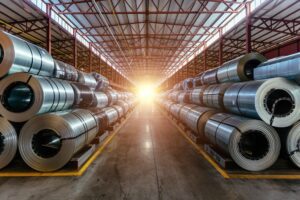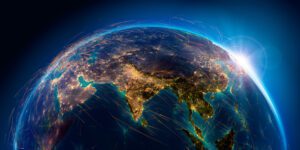On October 31, 2021, the United States and the European Union launched historic negotiations aimed at landing an agreement to increase trade in “green” steel and aluminum—that is, steel and aluminum produced in a way that emits lower greenhouse gas emissions than when steel is produced using conventional manufacturing practices. Were it to be concluded, the agreement—formally referred to as the Global Arrangement on Sustainable Steel and Aluminum (GASSA)—would represent a significant achievement in the United States’ trade and climate policy that has the potential to reshape global supply chains toward greater sustainability, protect the livelihoods of U.S. workers, and significantly contribute to industrial decarbonization.
These negotiations are playing out against the backdrop of American and European efforts to decarbonize their heavy industries to achieve net-zero climate targets by midcentury, as well as long-standing problems of excess capacity in global steel and aluminum markets. Steel and steel products have some of the highest embedded carbon content of all traded goods, and the iron and steel industry produces nearly one-third of global emissions from industry. Aluminum, meanwhile, is energy and carbon intensive and is consequential to global greenhouse gas emissions, albeit on a comparatively smaller scale.
Yet recent reporting reflects that GASSA negotiations have stalled on account of different U.S. and EU approaches to linking market access to the carbon intensity of traded goods, which may result in the deal being indefinitely shelved. This would be an immense missed opportunity. GASSA, if concluded in a way that links market access to carbon intensity, would mark a paradigm shift in the organization of cross-border commerce, one in which like-minded democracies use trade—and the institutions that facilitate and govern it—as a tool to address shared problems. Furthermore, by laying the groundwork for a transatlantic climate bloc, the deal would strengthen other U.S.-EU partnerships aimed at confronting some of the major global challenges of the 21st century—above all, climate change, but also the influence of authoritarian states in the international system and the need to recalibrate the global economy in a way that better serves the interests of workers and the planet.
This issue brief offers an overview of GASSA, explains why it matters, and examines challenges to its implementation. It assesses that a strong agreement would both constitute a major step forward in aligning trade with climate action and offer a productive mechanism for countering abuses of the global trading system by nonmarket economies while strengthening transatlantic relations. Finally, it recommends that if GASSA cannot move forward in a timely fashion, the United States should seek similar partnerships with other high-ambition steel- and aluminum-producing nations.
|
|
Despite the potential adverse effects of climate change, it is undeniable that these changes have significantly contributed to the growing interest of countries such as China in the Arctic region, with a particular focus on the maritime transport of resources extracted from the world’s high north. The Northern Sea Route, which some analysts expect to be “ice-free by 2050,” has received special attention from both China and Russia in recent years.
After completing a voyage between Vladivostok and Kaliningrad, Ivan Fedyushin, second officer aboard a sailing vessel, reported a striking observation: the previously prevalent ice fields across the Bering Sea, Chukotka Sea, and East Siberian Sea had disappeared. This vanishing ice serves as a significant indication of a profound change in the Arctic’s accessibility for all types of vessels. The melting Arctic ice offers major powers a key benefit: greater navigational access. This expansion not only extends the available months for using Arctic maritime routes to transport resources but also boosts the potential volume of cargo transported. A study supported by the Russian Science Foundation, employing satellite data and climate models, projected that the Northern Sea Route’s transit window will expand by approximately 4 to 6.5 months by the close of the 21st century.
The Northern Sea Route (NSR), connecting the Baltic Sea to the Bering Sea through Russia’s extensive Arctic, is known for providing faster navigation during ice-free periods, drawing the interest of various global players. A trip from Dalian, China, to Rotterdam, the Netherland along the NSR takes around 33 days, as opposed to the 48 days via the Suez Canal. The potential savings, in both time and money, explains why China and other nations are closely observing the Arctic and its potential for global shipping.
Understanding Northern Sea Route’s growing utilization means acknowledging the significant role played by Russia and China as policymakers in the region. After a Russian decree in 2015 approving the Route’s development until 2030, the Northern Sea Route saw a notable increase in the sea transport volume, rising by approximately 9 million tons between 2017 and 2018.
|
Following is an excerpt from ”The Positive Impact of US-China Trade War on Global South’s Position in the Global Value Chain” published by the Journal of World Trade Studies
Since 2018, the United States and China have been embroiled in a trade war. The trade war stems from US President Donald Trump’s decision to impose tariffs on several products and commodities imported from China. In response to the policy, China also imposed tariffs on several products and commodities imported from the US. Research conducted by Chad P. Bown (2022) from the Peterson Institute for International Economics shows that as of July 2018, the average US tariff on imports from China was still 3.8%. However, tariffs on imports from China gradually increased until they peaked at 21% in September 2019 and then dropped to 19.3% in February 2020…
…The conflict between the US and China prompted the two countries to reduce their dependence on each other. US manufacturing imports from China have decreased, while Asian countries categorized as low-cost countries, have increased. At the same time, the issue of reshoring US companies’ operations in China arose. A survey conducted by A.T. Kearney (2022) found that about 47% of executives of US manufacturing companies operating in China have moved part of their operations back to the US in the past three years. 29% said they would restore parts of their operations in the next three years, and 16%said they had considered reshoring but are yet to make a decision. In the survey, US company executives also outlined that their options also include Mexico, Canada, and Central American countries (nearshoring), not limited to reshoring to the US. This decision coincides with the trend of automation by US companies; instead of looking for cheap labor, they are replacing them with robots. The process creates challenges for countries that host part of US companies’ operations characterized by the labor-intensive and technology-laden process.
From the Chinese side, the disruption caused by the conflict with the US encourages them to become more economically self-sufficient. Such efforts to achieve self-sufficiency are made through the dual circulation model, which includes changing the growth model from export-based to domestic consumption and reducing dependence on imports. Concerning the second element, according to the Economist Intelligence Unit (2020), China focuses on three sectors. First, technology with a priority towards semiconductors. China provides fiscal incentives and subsidies, and encourages cooperation between industries and universities to reduce dependence on US semiconductor companies or companies from other countries that use US technology. China also provides fiscal incentives and subsidies, and encourages cooperation between industries and universities. The second sector is energy. China does not rely on the US or its allies for energy supplies, however, shipping oil and gas by sea is vulnerable to a blockade or interception. The threat of a blockade prompted China to increase its renewable energy sector investment. The third sector is food. China’s agricultural sector is labor-intensive, but they experience labor shortage and are dependent on imports of seed and technology. This limitation prompted a policy of agriculture modernization from labor-intensive to technology-intensive.
|
|





